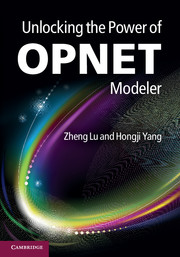Book contents
- Frontmatter
- Contents
- Preface
- List of abbreviations
- Part I Preparation for OPNET Modeling
- 1 Introduction
- 2 Installation of OPNET Modeler and setting up environments
- 3 OPNET Modeler user interface
- Part II Modeling Custom Networks and Protocols
- Part III Modeling and Modifying Standard Networks and Protocols
- Part IV OPNET Modeling Facilities
- References
- Index
2 - Installation of OPNET Modeler and setting up environments
from Part I - Preparation for OPNET Modeling
Published online by Cambridge University Press: 05 February 2012
- Frontmatter
- Contents
- Preface
- List of abbreviations
- Part I Preparation for OPNET Modeling
- 1 Introduction
- 2 Installation of OPNET Modeler and setting up environments
- 3 OPNET Modeler user interface
- Part II Modeling Custom Networks and Protocols
- Part III Modeling and Modifying Standard Networks and Protocols
- Part IV OPNET Modeling Facilities
- References
- Index
Summary
This chapter shows the steps for installing and configuring the OPNET Modeler and its related environment variables. Having followed this chapter, one should be able to run the OPNET Modeler correctly. If OPNET Modeler and relevant software have already been installed and environment variables have been configured on the target machine, this chapter can be skipped. If you have problems compiling OPNET models, especially, compiling standard OPNET models which should have no compilation and linking errors, please check this chapter to make sure your software is properly installed and environment variables are correctly configured, since many OPNET model compilation and linking errors come from incorrect configuration of the C/C++ compiler's environment variables.
This chapter first describes the system requirements for using OPNET Modeler, including both hardware and software requirements. Then it shows the steps for installing and configuring OPNET Modeler on both Windows and Linux operating systems respectively.
System requirements for using OPNET Modeler
This section lists the requirements for using OPNET Modeler 14.5 and later versions, and also highlights the relevant key points. For other versions of OPNET Modeler, please check the system requirements datasheet and installation manual shipped with corresponding products, or visit the OPNET website for more information (www.opnet.com). Tables 2.1–2.3 list the system support and hardware and software requirements for using OPNET Modeler.
Installation on Windows
On Windows, you need to install OPNET Modeler and Microsoft Visual Studio or Microsoft Visual C++ for OPNET Modeler to compile C/C++ based simulation models.
Information
- Type
- Chapter
- Information
- Unlocking the Power of OPNET Modeler , pp. 11 - 23Publisher: Cambridge University PressPrint publication year: 2012
